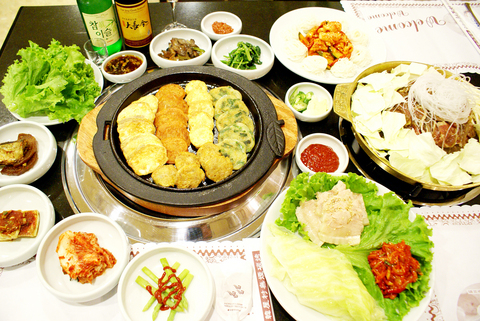Korea House Village (韓屋村)
Address: 3, Ln 105, Shida Rd, Taipei
(台北市師大路105巷3號)

PHOTO: NOAH BUCHAN, TAIPEI TIMES
Telephone: (02) 2364-1980
Open: Daily from noon to midnight
Average meal: NT$1,000 for two, plus 10 percent service charge
Details: Chinese and Korean menu (English menu coming soon)
Proprietors of Korean restaurants in Taiwan often say the food they serve has been changed to suit local palettes, whatever that means. It sounds like some feeble excuse not to put the proper amount of effort into making the pastes and sauces, for which any Korean will tell you is as important as the meat or seafood it's served with, or slicing the meat used for barbecue so thin that it could only grace a hot pot.
Not so with the recently opened Korea House Village. Proprietor Zhao Yi-xian (趙懿憲) is unwilling to compromise authenticity to suite local tastes. Instead, he transplants 10 years of experience operating a restaurant in South Korea, where his mother-in-law grew the peppers and soy beans that go into making the pastes and sauces, to Shida. Three years in the planning, the tableware, the tables and chairs, even the cutlery is imported from South Korea. The walls are lined with tastefully finished traditional Korean art and glass display cases containing expensive ginseng alcohol.
Authentic Korean restaurants are worth a visit if only to sample the free appetizer dishes they serve before the meal. Korea House Village serves up six, and on the day we were there included asparagus, kimchi, pickled eggplant, mackerel and white radish marinated in light soy sauce, tofu in a light soy and ginger sauce topped with green onions and green vegetables marinated in sesame oil. Zhao says that aside from kimchi, the dishes change with the season.
Other specialties on the menu include tempura (NT$250) — a selection of white fish, squash, green onion mini pancakes and kimchi mini-pancakes — that is served with red-pepper paste infused with fresh garlic, hints of ginger and green onions. The exterior of each was crispy with the pancakes chewy on the inside and the fish light in flavor. The octopus and fresh cucumber salad marinated in hot sauce and surrounded by eight noodle nests (NT$300) was zingy.
A good deal for two is the bulgogi (NT$500), or marinated barbecue beef. Served with tofu, noodles, vegetables and seafood on a large iron plate, the mixture is then pan-barbecued and eaten straight up or with fresh lettuce leaves. The menu also offers an extensive selection of grilled barbecue dishes.

In the March 9 edition of the Taipei Times a piece by Ninon Godefroy ran with the headine “The quiet, gentle rhythm of Taiwan.” It started with the line “Taiwan is a small, humble place. There is no Eiffel Tower, no pyramids — no singular attraction that draws the world’s attention.” I laughed out loud at that. This was out of no disrespect for the author or the piece, which made some interesting analogies and good points about how both Din Tai Fung’s and Taiwan Semiconductor Manufacturing Co’s (TSMC, 台積電) meticulous attention to detail and quality are not quite up to

April 21 to April 27 Hsieh Er’s (謝娥) political fortunes were rising fast after she got out of jail and joined the Chinese Nationalist Party (KMT) in December 1945. Not only did she hold key positions in various committees, she was elected the only woman on the Taipei City Council and headed to Nanjing in 1946 as the sole Taiwanese female representative to the National Constituent Assembly. With the support of first lady Soong May-ling (宋美齡), she started the Taipei Women’s Association and Taiwan Provincial Women’s Association, where she

Chinese Nationalist Party (KMT) Chairman Eric Chu (朱立倫) hatched a bold plan to charge forward and seize the initiative when he held a protest in front of the Taipei City Prosecutors’ Office. Though risky, because illegal, its success would help tackle at least six problems facing both himself and the KMT. What he did not see coming was Taipei Mayor Chiang Wan-an (將萬安) tripping him up out of the gate. In spite of Chu being the most consequential and successful KMT chairman since the early 2010s — arguably saving the party from financial ruin and restoring its electoral viability —

It is one of the more remarkable facts of Taiwan history that it was never occupied or claimed by any of the numerous kingdoms of southern China — Han or otherwise — that lay just across the water from it. None of their brilliant ministers ever discovered that Taiwan was a “core interest” of the state whose annexation was “inevitable.” As Paul Kua notes in an excellent monograph laying out how the Portuguese gave Taiwan the name “Formosa,” the first Europeans to express an interest in occupying Taiwan were the Spanish. Tonio Andrade in his seminal work, How Taiwan Became Chinese,